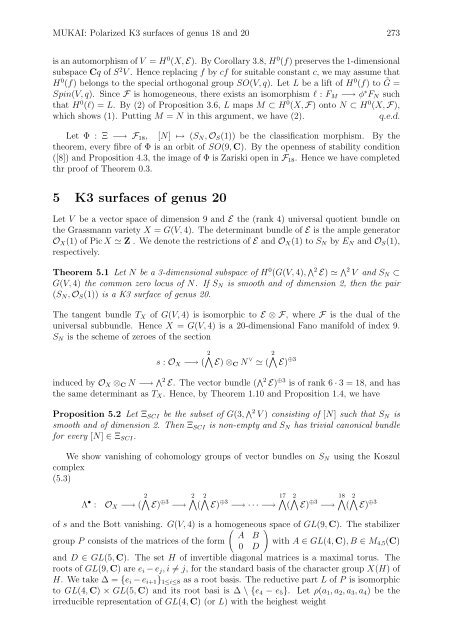Polarized K3 surfaces of genus 18 and 20 - Research Institute for ...
Polarized K3 surfaces of genus 18 and 20 - Research Institute for ...
Polarized K3 surfaces of genus 18 and 20 - Research Institute for ...
Create successful ePaper yourself
Turn your PDF publications into a flip-book with our unique Google optimized e-Paper software.
MUKAI: <strong>Polarized</strong> <strong>K3</strong> <strong>surfaces</strong> <strong>of</strong> <strong>genus</strong> <strong>18</strong> <strong>and</strong> <strong>20</strong> 273<br />
is an automorphism <strong>of</strong> V = H 0 (X, E). By Corollary 3.8, H 0 (f) preserves the 1-dimensional<br />
subspace Cq <strong>of</strong> S 2 V . Hence replacing f by cf <strong>for</strong> suitable constant c, we may assume that<br />
H 0 (f) belongs to the special orthogonal group SO(V, q). Let L be a lift <strong>of</strong> H 0 (f) to ˜G =<br />
Spin(V, q). Since F is homogeneous, there exists an isomorphism l : F M −→ φ ∗ F N such<br />
that H 0 (l) = L. By (2) <strong>of</strong> Proposition 3.6, L maps M ⊂ H 0 (X, F) onto N ⊂ H 0 (X, F),<br />
which shows (1). Putting M = N in this argument, we have (2).<br />
q.e.d.<br />
Let Φ : Ξ −→ F <strong>18</strong> , [N] ↦→ (S N , O S (1)) be the classification morphism. By the<br />
theorem, every fibre <strong>of</strong> Φ is an orbit <strong>of</strong> SO(9, C). By the openness <strong>of</strong> stability condition<br />
([8]) <strong>and</strong> Proposition 4.3, the image <strong>of</strong> Φ is Zariski open in F <strong>18</strong> . Hence we have completed<br />
thr pro<strong>of</strong> <strong>of</strong> Theorem 0.3.<br />
5 <strong>K3</strong> <strong>surfaces</strong> <strong>of</strong> <strong>genus</strong> <strong>20</strong><br />
Let V be a vector space <strong>of</strong> dimension 9 <strong>and</strong> E the (rank 4) universal quotient bundle on<br />
the Grassmann variety X = G(V, 4). The determinant bundle <strong>of</strong> E is the ample generator<br />
O X (1) <strong>of</strong> Pic X ≃ Z . We denote the restrictions <strong>of</strong> E <strong>and</strong> O X (1) to S N by E N <strong>and</strong> O S (1),<br />
respectively.<br />
Theorem 5.1 Let N be a 3-dimensional subspace <strong>of</strong> H 0 (G(V, 4), ∧2 E) ≃ ∧2 V <strong>and</strong> S N ⊂<br />
G(V, 4) the common zero locus <strong>of</strong> N. If S N is smooth <strong>and</strong> <strong>of</strong> dimension 2, then the pair<br />
(S N , O S (1)) is a <strong>K3</strong> surface <strong>of</strong> <strong>genus</strong> <strong>20</strong>.<br />
The tangent bundle T X <strong>of</strong> G(V, 4) is isomorphic to E ⊗ F, where F is the dual <strong>of</strong> the<br />
universal subbundle. Hence X = G(V, 4) is a <strong>20</strong>-dimensional Fano manifold <strong>of</strong> index 9.<br />
S N is the scheme <strong>of</strong> zeroes <strong>of</strong> the section<br />
2∧ 2∧<br />
s : O X −→ ( E) ⊗C N ∨ ≃ ( E)<br />
⊕3<br />
induced by O X ⊗ C N −→ ∧2 E. The vector bundle ( ∧2 E) ⊕3 is <strong>of</strong> rank 6 · 3 = <strong>18</strong>, <strong>and</strong> has<br />
the same determinant as T X . Hence, by Theorem 1.10 <strong>and</strong> Proposition 1.4, we have<br />
Proposition 5.2 Let Ξ SCI be the subset <strong>of</strong> G(3, ∧2 V ) consisting <strong>of</strong> [N] such that S N is<br />
smooth <strong>and</strong> <strong>of</strong> dimension 2. Then Ξ SCI is non-empty <strong>and</strong> S N has trivial canonical bundle<br />
<strong>for</strong> every [N] ∈ Ξ SCI .<br />
We show vanishing <strong>of</strong> cohomology groups <strong>of</strong> vector bundles on S N<br />
complex<br />
(5.3)<br />
using the Koszul<br />
2∧<br />
Λ • : O X −→ ( E) ⊕3 −→<br />
2∧<br />
( 2 ∧<br />
E) ⊕3 −→ · · · −→<br />
17∧<br />
( 2 ∧<br />
E) ⊕3 −→<br />
<strong>18</strong>∧<br />
( 2 ∧<br />
E)<br />
⊕3<br />
<strong>of</strong> s <strong>and</strong> the Bott vanishing. G(V, 4) is a homogeneous ( ) space <strong>of</strong> GL(9, C). The stabilizer<br />
A B<br />
group P consists <strong>of</strong> the matrices <strong>of</strong> the <strong>for</strong>m<br />
with A ∈ GL(4, C), B ∈ M<br />
0 D<br />
4,5 (C)<br />
<strong>and</strong> D ∈ GL(5, C). The set H <strong>of</strong> invertible diagonal matrices is a maximal torus. The<br />
roots <strong>of</strong> GL(9, C) are e i − e j , i ≠ j, <strong>for</strong> the st<strong>and</strong>ard basis <strong>of</strong> the character group X(H) <strong>of</strong><br />
H. We take ∆ = {e i − e i+1 } 1≤i≤8 as a root basis. The reductive part L <strong>of</strong> P is isomorphic<br />
to GL(4, C) × GL(5, C) <strong>and</strong> its root basi is ∆ \ {e 4 − e 5 }. Let ρ(a 1 , a 2 , a 3 , a 4 ) be the<br />
irreducible representation <strong>of</strong> GL(4, C) (or L) with the heighest weight
















